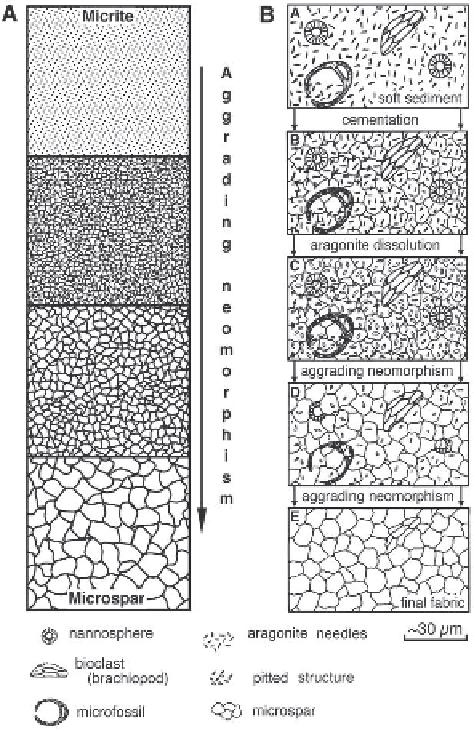Geology Reference
In-Depth Information
thermocline-layer depths (200 to 800 m) and in areas
of strong currents. This process can transform sedi-
mentary grain-support fabrics into diagenetic mud-
support fabrics, and thus give the paleoenvironmental
interpretation a wrong direction.
A cyanobacterial origin of micrite cements has been
described from Pleistocene carbonates (Kazmierczak
and Iryu 1999).
(12) Recrystallization and grain diminution:
Recrys-
tallization of grains (e.g. peloids, see Sect. 4.2.2) and
grain-diminution
(Orme and Brown 1963) of skeletal
grains are further possibilities for the formation of a
'micrite' fabric.
Grain diminution
(degrading neomor-
phism) takes place both during early diagenetic and
burial diagenetic phases (Dixon and Wright 1983). It
results in a replacement of former larger crystals by
tiny crystals due to changes in crystal texture or changes
in mineralogy. Examples are known from modern and
ancient algal carbonates, where early diagenetic mi-
crocrystalline cements are formed within the algal frame-
work (Alexandersson 1977). The dissolution of sparry
cements in grain-supported limestones and the precipi-
tation of microcrystalline cement (Wardlaw 1962; spar-
micritization, Kahle 1977) can also cause the forma-
tion of diagenetic micrite. Alteration of skeletal grains
due to a combination of micritization and recrystalli-
zation lead to the formation of modern lagoonal muds
composed of micrite-sized clumps of equant anhedral Mg-
calcite crystals about 0.5
m in size (Reid et al. 1992).
Fig. 4.5.
Two models explaining the formation of microspar
textures in fine-grained limestones.
4.1.3 Microspar
A:
Aggrading neomorphism (slightly modified from Folk
1959, 1965). The microspar texture is formed by the
conversion of smaller High-Mg calcite crystals (top) to larger
calcite crystals (bottom) by gradual enlargement maintaining
a uniform crystal size at all given times.
B:
Transformation of aragonite-dominated lime mud to
microspar without a micrite stage (modified after Lasemi and
Sandberg 1984). The sketch, based on the investigation of
microcrystalline Silurian limestones, illustrates the processes
leading to the formation of microspar (after Munnecke 1997).
The precursor carbonate mud (top, A) consists of aragonite
needles, Low-Mg calcitic and High-Mg calcitic and aragonitic
bioclasts, and clay minerals. Cementation (B) in intergranular
pores starts with the precipitation of microspar crystals that
enclose smaller aragonite needles and bioclasts in the sediment
close to the sea bottom.
The boundaries of the microspar crystals are accentuated
by clay seams. The dissolution of aragonite needles causes
pit-like structures (C).
Aggrading neomorphism (D and E) destroys larger
bioclastic grains and produces the final microspar fabric. Note
that the size and the shape of microspar crystals are determined
in a one-step process by cementation (B), in contrast to the
Folk model according to which the microspar fabric originates
at the end of a long-lasting process.
Microcrystalline carbonate rocks display a wide
range of mean crystal sizes. For examples see Pl. 6/2;
Pl. 47/2, Pl. 91/7). Folk (1959, 1965) distinguished be-
tween 'micrites' (<4
m) and 'microspar' (4-30
m).
Definition
: The term refers to a fine-grained calcite
matrix, characterized by rather uniformly sized and gen-
erally loaf-shaped, subhedral and euhedral calcite crys-
tals ranging from 5 to more than 20
m in diameter
(Folk 1959). Other authors use different crystal size
limits: 4-10
m (Tucker 1981) or 5-50
m (Bathurst
1975). Further criteria are a mosaic-like microtexture,
equant grain shapes and boundaries, pits within the crys-
tals (interpreted as a result of the dissolution of former
aragonite needles enclosed in poikilotopic calcite crys-
tals), impurities of clay or organic matter between the
crystals, sometimes a patchy distribution within the mi-
crite, and the association of microsparitic limestones
with shaley interbeds.
Microsparite
is a limestone

